Just In
- 2 hrs ago

- 2 hrs ago

- 7 hrs ago

- 11 hrs ago

Don't Miss
- Finance
 Rs 2.50/Share Final Dividend: Record Date In Due Course; Buy The ITC Group Stock?
Rs 2.50/Share Final Dividend: Record Date In Due Course; Buy The ITC Group Stock? - Sports
 Who Won Yesterday's IPL Match 33? PBKS vs MI, IPL 2024 on April 17: Mumbai Indians Escape Last-Ditched Fight by Punjab Kings To Win
Who Won Yesterday's IPL Match 33? PBKS vs MI, IPL 2024 on April 17: Mumbai Indians Escape Last-Ditched Fight by Punjab Kings To Win - Movies
 Do Aur Do Pyaar OTT Release Date & Platform: When & Where To Watch Vidya Balan’s Film After Theatrical Run?
Do Aur Do Pyaar OTT Release Date & Platform: When & Where To Watch Vidya Balan’s Film After Theatrical Run? - News
 BRS Chief K Chandrasekhar Rao Slams BJP, Says K Kavitha's Arrest Is Vendetta Politics
BRS Chief K Chandrasekhar Rao Slams BJP, Says K Kavitha's Arrest Is Vendetta Politics - Automobiles
 Aprilia RS 457 Accessories: A Detailed Look At The Prices
Aprilia RS 457 Accessories: A Detailed Look At The Prices - Education
 Karnataka SSLC Result 2024 Soon, Know How to Check Through Website, SMS and Digilocker
Karnataka SSLC Result 2024 Soon, Know How to Check Through Website, SMS and Digilocker - Technology
 Nothing Ear, Ear a With ANC, Up to 42.5 Hours of Battery Launched; Check Price and Availability
Nothing Ear, Ear a With ANC, Up to 42.5 Hours of Battery Launched; Check Price and Availability - Travel
Telangana's Waterfall: A Serene Escape Into Nature's Marvels
World First Aid Day 2020: 10 Quick First Aid Tips And Essential Items For A First Aid Kit
Every year, World First Aid Day is observed on the second Saturday of September to raise public awareness of how first aid can save lives in everyday-crisis situations. The International Federation of Red Cross and Red Crescent Societies (IFRC) initiated the World First Aid Day in 2000.
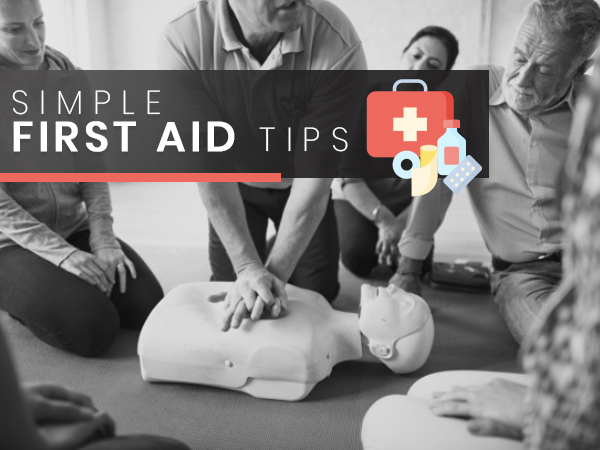
First Aid help started over 160 years back, at the Battle of Solferino in North Italy. The central theme and objective of World First Aid Day are that first aid knowledge and skills must be made available to ALL. World First Aid Day 2020 theme is First Aid Saves Lives.
Today, we will let you know of some of the easiest and quickest first aid tips and tricks, that you will actually use and can save your or someone else's day. Take a look.
Quick First Aid Tips
Knowing the basics of first aid is a necessity for anyone. Being aware of what has to be done and when during a situation that needs medical attention is always a plus point. Read on to know the basic and essential first aid tips that will help you see the difference between what helps and what doesn't.
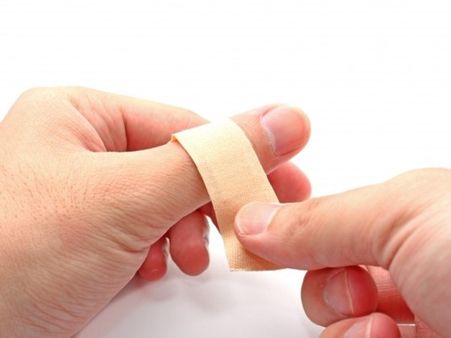
1. First Aid For Cut And Scrapes
To treat a minor cut or a scrape, follow these steps:
- First, wash your hands with soap and water to avoid bacteria getting into the cut and causing an infection - you can also use a sanitiser if the soap is not available.
- Put pressure on the cut with a gauze pad or clean cloth to stop the bleeding.
- Once the bleeding has stopped, clean the wound by keeping it under cold running water or use a saline wound wash.
- Do NOT get soap in the wound or cut.
- Using a pair of sanitised tweezers, gently remove any dirt or debris.
Do I need to bandage a cut: Not every cut or scrape has to be bandaged. However, if the cut is on the part of the body that might get dirty or rub against clothes, put on a bandage to protect it. Change the bandage every day or whenever it gets dirty (or wet) [1].
When to see a doctor: If the cut is deep, long, or the edges are jagged, if the cut or scrape is from a dirty or rusty object and/or if you cannot stop the bleeding.

2. First Aid For A Bloody Nose
Dry air and nose picking are the two most common causes for sudden nose bleeding [2]. To treat a bloody nose, follow these steps:
- Lean slightly forward and NOT back.
- Pinch the nose just below the bridge.
- Do not pinch the nostrils closed by pinching lower.
- Check after five minutes to see if bleeding has stopped.
- If not, continue pinching and check after another 10 minutes.
- You can also apply a cold pack to the bridge of the nose while pinching.
When to see a doctor: If your nose starts bleeding and you have not done something to traumatise it, consult a doctor immediately.
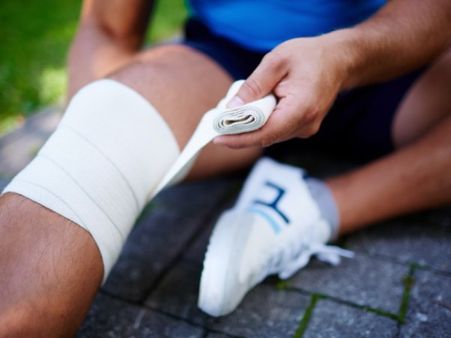
3. First Aid For Sprains
Sprains and strains are common injuries, and you are most likely to get a sprain in the wrist or ankle, and causes pain, bruising, and swelling [3]. To treat a sprain, follow these steps:
- Rest the sprained limb.
- You can also ice the area using a cold pack.
- Try to ice the area as soon as possible after the injury and continue to ice it for 15 to 20 minutes.
- Do this four to eight times a day, for the first 48 hours or until swelling improves.
- Some of the other first aid tips for sprains are compressing the area with a bandage, elevating the injured limb above your heart whenever possible to help prevent or reduce swelling.
Note: You should always seek medical treatment to make sure the injury is not more serious or even to avoid causing further injury. If it is a fracture, do not try to straighten the wound.
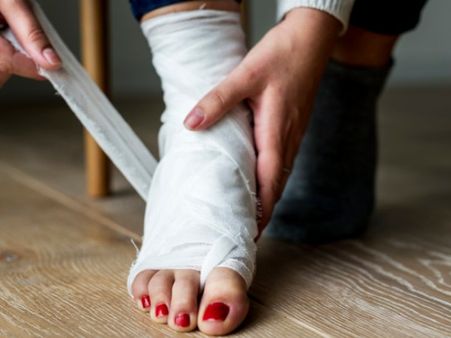
4. First Aid For Fractures
It is not always easy to understand whether it is a fracture, sprain or a broken bone, so, treat all extremity injuries as fractures, just to be cautious [4]. To treat a fracture, follow these steps:
- Do NOT try to straighten it.
- Stabilise your limb using a splint and padding.
- Lightly place a cold pack on the injury (avoid placing ice directly on the skin).
- Keep the suspected fracture elevated.
- In the meantime, you can manage the pain by taking anti-inflammatory medications.

5. First Aid For Minor Burns
The first step in treating a burn is to stop the burning, which could be caused by chemicals or any other elements [5]. That is, switch off the electricity supply, wash or wipe off the chemicals and cool off the heat. First-degree burns turn red and may swell, second-degree burns can form blisters, and third-degree burns make the skin look charred [6]. To treat burns, follow these steps:
- Run the burned area with cold running water for several minutes.
- Do not use ice for this.
- Apply a gauze bandage lightly without any ointments or oils.
- Take pain relievers, if necessary.
- If any blisters have formed, do NOT break them.
When to see a doctor: Serious burns need to be treated by a doctor or in a hospital and if your burn is larger than 2 to 3 inches and is on the face, hands, feet, or over a joint like your shoulder or knee, immediately get professional help.
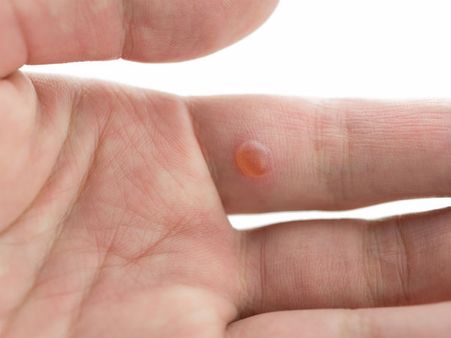
6. First Aid For Blisters
If the blister is small, unbroken and not painful, it is best to let it be. You can cover it to avoid continued rubbing as the pressure can cause it to swell more and burst open [7]. If the blister is large or painful, it is best to pop it open safely. To treat blisters, follow these steps:
- Sterilise a needle or a sharp thin object like a pin and make small punctures (by lightly poking) at the edge of the blister.
- Press lightly so that the fluid comes out of the blister.
- Apply an antibiotic ointment and cover to protect the blister from further rubbing and pressure.

7. First Aid For Bleeding
Almost all bleedings can be stopped with timely intervention, be it severe or mild. Usually, mild bleedings stop on its own, and severe bleeding, if not stopped, can lead to shock and death [8]. To treat bleedings, follow these steps:
- Cover the wound or the cut with a gauze (or a cloth).
- Apply direct pressure to the wound to stop the blood flow.
- Keep the cloth on the bleeding and add more layers, if needed.
- Applying the cloth over the wound helps clots form to stop the flow.
Note: Doctors say that one should never apply a tourniquet over an open cut or wound.

8. First Aid For Bee Stings
Bee stings are extremely painful, and in some cases, can be deadly if the person is allergic to bee venom [9]. To treat bee stings, follow these steps:
- First, you need to remove the stinger of the bee from the location of the bee sting.
- Use a cold pack to reduce swelling at the site.
- Use antihistamines to reduce swelling and itching.
- You can also use painkillers to ease the severe pain caused by the sting.
Note: Make sure you monitor the bee sting and check whether there are any developments such as hives, redness or itching in other areas of the body, and shortness of breath.

9. First Aid For Frostbite
Frostbite can be termed as an injury, caused due to exposure to extreme or prolonged cold. Your skin and the underlying tissues get affected and commonly affects the fingers, toes, nose, ears, cheeks and chin [10]. To treat frostbites, follow these steps:
- Get out of the cold first.
- You can rewarm small areas of minor frostbite through skin-to-skin contact.
- Avoid using hot water bags or hot packs.
Note: Treating frostbite is a gradual process and if possible, should be done by professionals. Suppose there are no hospitals or medical facilities nearby. In that case, you can immerse the affected area in warm water for 20 to 30 minutes [11].
Caution: Do not rub the affected area.
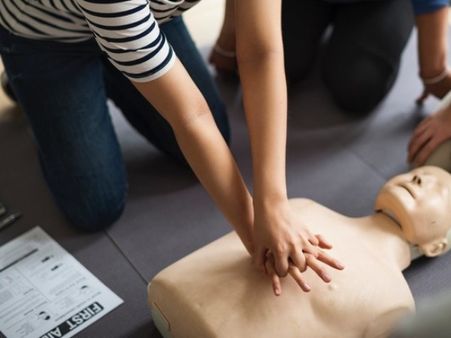
10. First Aid For Heart Attacks
If a person is suffering from a cardiac arrest, performing cardiopulmonary resuscitation (CPR) can help save their lives [12].
If the heart attack victim is awake and responding, these are the ways in which you can help them, and they are:
- Give 324 mg of baby aspirin or 325 mg of an adult aspirin; it can help inhibit the blood platelets that cause blood clotting.
- Please make sure the person CHEW the pill and NOT SWALLOW it or take it with water.
- Place one hand over the other on the centre of the chest near the nipple area and push hard and fast.
- Try doing 100-120 compressions per minute (follow the beat of the song Stayin' Alive by Bee Gees) [14].
- Don't fear when you are performing CPR.
If the person is unconscious and still breathing normally, lower the person to the ground and keep his head relaxed in an erect position [13].
If the person is unconscious and not breathing, doing CPR would help limit the damage. Start chest compressions, even if you do not have professional training.
Defibrillation is another first aid treatment method for heart attack victims. Many public places have automatic external defibrillators (AED). This portable electronic device gives an electric shock to the heart to restore its normal rhythm [15].
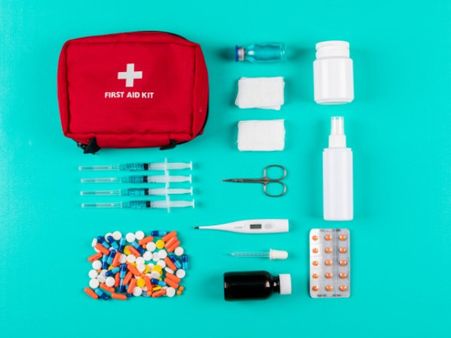
Essentials You Must Have In Your First Aid Kit
A basic first aid kit should contain the following:
- Tweezers
- Scissors
- Antiseptic creams
- Antibiotic ointments
- Antiseptic wash
- Adhesive and elastic bandages
- Tape and sterile gauze
- Muscle pain spray or cream
- Pain relievers
- Thermometer and fever medicine
- Allergy medicine
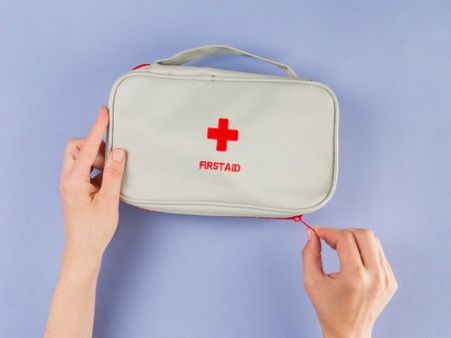
On A Final Note…
Learning first aid is one of the easiest and valuable skills that can save a life. Do not just stock your first aid kit once; make sure to clean and restock the medicines every month to throw out the expired medications.
-
 pulseWorld First Aid Day 2022: Date, History, Significance And Theme
pulseWorld First Aid Day 2022: Date, History, Significance And Theme -
 wellnessWorld First Aid Day 2020: Common First Aid Mistakes To Avoid
wellnessWorld First Aid Day 2020: Common First Aid Mistakes To Avoid -
 wellnessWorld First Aid Day 2020: Common Ayurvedic Remedies That Can Be Used In A First Aid Box
wellnessWorld First Aid Day 2020: Common Ayurvedic Remedies That Can Be Used In A First Aid Box -
 wellnessWorld First Aid Day 2022: 20 Must-Have Items For Your First Aid Kit
wellnessWorld First Aid Day 2022: 20 Must-Have Items For Your First Aid Kit


 Click it and Unblock the Notifications
Click it and Unblock the Notifications



